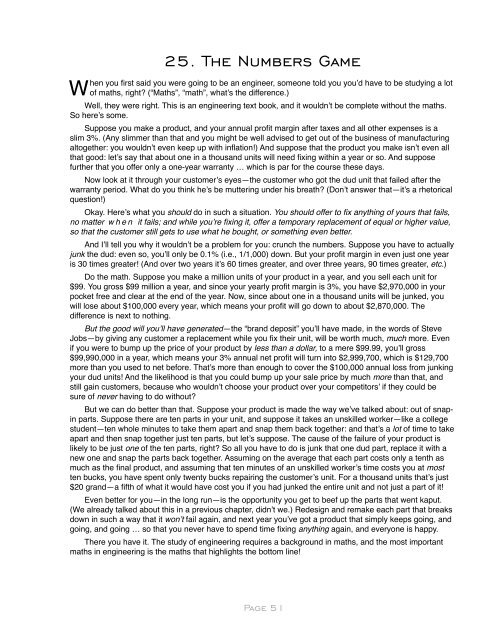Common Sense 101 - Engineering - December 16, 2012 Edition
You also want an ePaper? Increase the reach of your titles
YUMPU automatically turns print PDFs into web optimized ePapers that Google loves.
W<br />
25. The Numbers Game<br />
hen you first said you were going to be an engineer, someone told you you’d have to be studying a lot<br />
of maths, right? (“Maths”, “math”, what’s the difference.)<br />
Well, they were right. This is an engineering text book, and it wouldn’t be complete without the maths.<br />
So here’s some.<br />
Suppose you make a product, and your annual profit margin after taxes and all other expenses is a<br />
slim 3%. (Any slimmer than that and you might be well advised to get out of the business of manufacturing<br />
altogether: you wouldn’t even keep up with inflation!) And suppose that the product you make isn’t even all<br />
that good: let’s say that about one in a thousand units will need fixing within a year or so. And suppose<br />
further that you offer only a one-year warranty … which is par for the course these days.<br />
Now look at it through your customer’s eyes—the customer who got the dud unit that failed after the<br />
warranty period. What do you think he’s be muttering under his breath? (Don’t answer that—it’s a rhetorical<br />
question!)<br />
Okay. Here’s what you should do in such a situation. You should offer to fix anything of yours that fails,<br />
no matter when it fails; and while you’re fixing it, offer a temporary replacement of equal or higher value,<br />
so that the customer still gets to use what he bought, or something even better.<br />
And I’ll tell you why it wouldn’t be a problem for you: crunch the numbers. Suppose you have to actually<br />
junk the dud: even so, you’ll only be 0.1% (i.e., 1/1,000) down. But your profit margin in even just one year<br />
is 30 times greater! (And over two years it’s 60 times greater, and over three years, 90 times greater, etc.)<br />
Do the math. Suppose you make a million units of your product in a year, and you sell each unit for<br />
$99. You gross $99 million a year, and since your yearly profit margin is 3%, you have $2,970,000 in your<br />
pocket free and clear at the end of the year. Now, since about one in a thousand units will be junked, you<br />
will lose about $100,000 every year, which means your profit will go down to about $2,870,000. The<br />
difference is next to nothing.<br />
But the good will you’ll have generated—the “brand deposit” you’ll have made, in the words of Steve<br />
Jobs—by giving any customer a replacement while you fix their unit, will be worth much, much more. Even<br />
if you were to bump up the price of your product by less than a dollar, to a mere $99.99, you’ll gross<br />
$99,990,000 in a year, which means your 3% annual net profit will turn into $2,999,700, which is $129,700<br />
more than you used to net before. That’s more than enough to cover the $100,000 annual loss from junking<br />
your dud units! And the likelihood is that you could bump up your sale price by much more than that, and<br />
still gain customers, because who wouldn’t choose your product over your competitors’ if they could be<br />
sure of never having to do without?<br />
But we can do better than that. Suppose your product is made the way we’ve talked about: out of snapin<br />
parts. Suppose there are ten parts in your unit, and suppose it takes an unskilled worker—like a college<br />
student—ten whole minutes to take them apart and snap them back together: and that’s a lot of time to take<br />
apart and then snap together just ten parts, but let’s suppose. The cause of the failure of your product is<br />
likely to be just one of the ten parts, right? So all you have to do is junk that one dud part, replace it with a<br />
new one and snap the parts back together. Assuming on the average that each part costs only a tenth as<br />
much as the final product, and assuming that ten minutes of an unskilled worker’s time costs you at most<br />
ten bucks, you have spent only twenty bucks repairing the customer’s unit. For a thousand units that’s just<br />
$20 grand—a fifth of what it would have cost you if you had junked the entire unit and not just a part of it!<br />
Even better for you—in the long run—is the opportunity you get to beef up the parts that went kaput.<br />
(We already talked about this in a previous chapter, didn’t we.) Redesign and remake each part that breaks<br />
down in such a way that it won’t fail again, and next year you’ve got a product that simply keeps going, and<br />
going, and going … so that you never have to spend time fixing anything again, and everyone is happy.<br />
There you have it. The study of engineering requires a background in maths, and the most important<br />
maths in engineering is the maths that highlights the bottom line!<br />
Page 51



